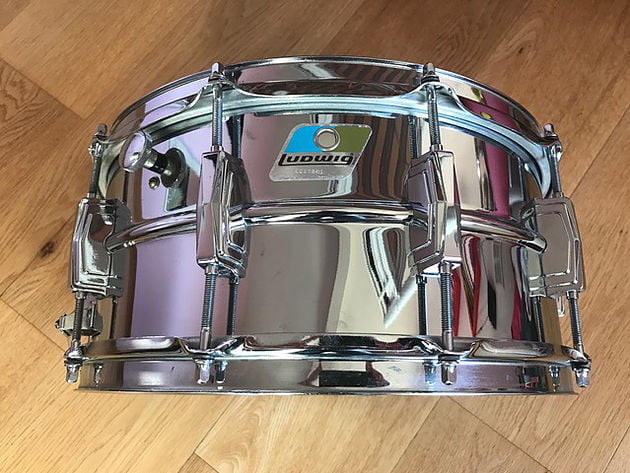In this article, we explore how to find your drumming roots.
I decided to get introspective and go about finding my drumming roots are to trace my lineage; my drumming family tree, if you will. Now, of course, I know who my favourite drummers are! But I wanted to look deeply into my earliest influences would shed a light into how these had an impact on my perception of rhythm, phrasing and groove.
In order to do this, I had chat with the person responsible for introducing me to music that influenced and inspired me at the earliest stages of my life; my mum. And, before we get going, it’s worth mentioning that I was born in 1983, which will help contextualise everything below.
MY DRUMMING ROOTS: 1980s & EARLY 1990s
During this period mum introduced me to some great artists and bands of a variety of different genres. Among these were Queen, The Beatles, Simon & Garfunkel, Phil Collins, John Denver, Elvis Presley, Neil Diamond, Barbara Streisand, and KC & The Sunshine Band.
It wasn’t actually until researching this article that I realised the impact that he’s in my life and where he fit in my drumming roots. Hal, who was part of the famous Wrecking Crew collective of session musicians in the 60s, played on most of the records that mum exposed me to. In retrospect, the take-away lesson from Hal was that, no matter who he was playing with, he played what the song and artist required of him.
The Beatles were my first favourite band; they probably still are – everything about them was catchy, and sounded great. Reflecting back on it, Ringo taught me that the drums could not only drive a song, but could also be catchy and a hook. In this context, a grooves don’t always have to have a solid back beat on 2 and 4. He taught me to appreciate the drums as a musically expressive instrument more than just a time keeper.
At the time, my knowledge of Queen extended only to the Greatest Hits records that were out at the time. Roger Taylor’s massive drum tones, feel, and songwriter approach to his parts were integral to the songs. In addition to this, how he chose to accent the back beat with slightly opened hi hats, like on Somebody To Love made a big impact on me.
Ralph Jones (Bill Haley & His Comets)
Listening to Bill Hayley’s music, there was an innocence to it particular to the 50’s with a rebellious streak that packed a punch. At the time rock ’n’ roll grooves were still being played swung over straight eighth guitar riffs, such as Whole Lotta Shakin’ Going On and Jailhouse Rock. And yet, what captivated me about Jones was his snare sound on those records, and his feel, and those killer snare rolls. His playing also taught me about using the bass drums as a means to accent notes rather than just provide a steady pulse.
MY DRUMMING ROOTS: MID 1990s
With my drumming roots firmly planted, by the mid 1990s I was bit more aware of the world, myself as a person and already playing guitar for a couple of years. I was on my own journey of musical discovery. Important bands that I started discovering, in no particular order, were Dire Straits, Faith No More, Criminal, Megadeth, Pearl Jam, Nirvana, Metallica and Cannibal Corpse, but the earliest ones from this period were as follows.
My first instrument was actually the guitar, so the focus of my musical foundations was more global than instrument-specific. I viewed songs as the sum of their parts with every component being as valuable as the other. With Nirvana writing such elegantly simple songs, Dave Grohl showed me that drum tracks needed to have energy; playing with intent and power. That keeping it simple is sometimes the best policy.
As for both my drumming roots and music development, Metallica are still one of those bands that I hold dear in my heart. I’m a huge fan of all their studio albums except, really, for Reload and St. Anger… With that in mind, Lars’ drum sounds, feel, grooves and fills made a huge impact on me. They complimented James Hetfield’s riffs flawlessly. Looking at the song-writing credits on their albums, Ulrich was right next to Hetfield, teaching me about partnerships and working with other musicians to draw the best out of a song. Yet more specifically, on a style level, Lars taught me all about landing on 1 but crashing on 2 with the snare. Signature stuff, and so effective!
Ok, so I was a bit of a late starter as a drummer, but as a kid, my cousin introduced me to Billy Cobham’s 1973 album Spectrum. This has got to give me some credibility as a drummer, I hope! The drums on that album were fast, furious, yet had a tribal feel about them. Their tone was open and natural, and the music was syncopated. But, beyond this, the album introduced me to odd time signatures early on. And because of this, and the fact that this stuff was never explained to me as a kid, odd time signatures were never about odd time signatures, but about feel and how music could flow in different ways.
Before Wikipedia was a CD version of the internet called Microsoft Encarta. On the ’95 edition, which we had, if you searched for “Rock music” or “Electric guitar”, you’d get some audio samples from a couple bands. One of these was Soundgarden’s track Nothing To Say” from 1988’s Screaming Life / Fopp. The sample was only 30 seconds long or so… But that slow, brooding groove, the grace notes, off-kilter accents over the dark riffs and soaring vocals became a big part of my drumming roots.
Conclusion
Finding my drumming roots has been a great exercise, and a fun one at that! It’s let me revisit great memories, and given me a better understanding of myself as a drummer. I would totally encourage you to do the same if you haven’t. If you’re interested in listening to the albums that I refer to above see the list below then check ‘em out on Spotify, Apple Music or preferred music streaming service.
Albums
The Beatles Help (1964), Rubber Soul (1965), Anthology 2 (1996), Beatles For Sale (1964), Live At The BBC (1994) – Drums: Ringo Starr
Phil Collins … But Seriously (1989) – Drums: Phil Collins
Dire Straits On Every Street (1991) – Drums: Jeff Porcaro, Manu Katché
Pearl Jam Ten (1991) – Drums: Dave Krusen, Vs. (1993) – Drums: Dave Abbruzzese
Nirvana Nevermind (1991) – Drums: Dave Grohl, Bleach (1989) – Drums: Chad Channing, Dale Grover
Soundgarden Screaming Life / Fopp (1990), Superunknown (1994) – Drums: Matt Cameron
Billy Cobham Spectrum (1973) – Drums: Billy Cobham
Megadeth Countdown To Extinction (1991), Youthanasia (1994) – Drums: Nick Menza
Queen Greatest Hits I (1981), Greatest Hits II (1991) – Drums: Roger Taylor
Metallica Master Of Puppets (1986), Metallica (1991) – Drums: Lars Ulrich
Bill Haley & His Comets Greatest Hits (N/A) – Drums: Ralph Jones
Criminal Victimzed (1994) – Drums: J.J. Vallejo









